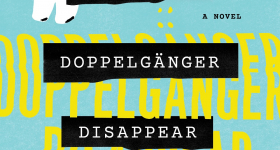On a sunny Saturday morning in downtown Oakland, I met with the legendary Helen Zia, well-known journalist and activist who has covered Asian American issues for decades. Zia generously opened up about the process of writing her recently published book, Last Boat Out of Shanghai: The Epic Story of the Chinese Who Fled Mao’s Revolution (2020 paperback). The colossal volume focuses on the 1949 exodus of millions of people from Shanghai due to the Communist government takeover. While Zia is well known in the Asian American community for her activism and journalism, I felt compelled that morning to ask her about her recent historical work, for personal as well as literary reasons. Like many Asian Americans, both of my parents fled the country as children during the exodus, as did most of my extended family and friends of their generation. While my father's family was privileged and could choose their method and time of departure, my mother had always told me she was on the last boat out of Shanghai. I could feel the anxiety that the experience had left upon her and almost visualize the crowds pushing onto the boat. After talking with Zia, I realized that the interview had spawned instead a meditation on her book and what it meant as an intervention into history, memory, and Asian American heritage.
The myriad ways that people left China during the exodus of 1949, from every background imaginable, are the stories that led to Zia’s rigorously researched book. While Chinese language books on the subject focus on oral histories, her book is a narrative work. Because of its treatment of the political forces in the narrative, the book has been banned in China, thus signaling its importance for readers — it offers a voice to those previously afraid or shy of speaking out because of government repercussions.
Last Boat is simultaneously everyone’s story and nobody’s. If the countless claims to being on the last boat are to be believed, that legendary boat would have sunk to the bottom of the ocean.
This book chronicles the true stories of four people — Benny, Bing, Annuo and Ho — who experienced the 1949 mass exodus from Shanghai as people fled to satellite Asian countries, the Americas, Australia and Europe. Their four stories appear in alternating chapters so that a reader can experience four lives reacting to the same key moments in time — at times a feat of mnemonic juggling, but as each story gains traction, things flow. The most dramatic trajectory is that of Benny, the privileged son of the famed Shanghai police chief who had collaborated with the Japanese. Post-1949, Benny quietly hid himself away in a Chinese library developing card catalogs. Bing, Zia’s mother, was abandoned twice as a child but survived to raise her family in America. Annuo, the daughter of Nationalists, escaped to Taiwan and experienced the White Terror. Ho, the son of landowners, eventually forged an engineering career in New York. Zia created her four stories from interviews, historical artifacts and documents, and her own abilities to generate narrative. She operated as a historian and journalist, but also embraced her own position as a daughter and descendant of the Republican period in China when the exodus took place. Zia’s strong personal connection to each of the four individuals surfaces in her intimate accounts of their lives.
Last Boat is simultaneously everyone’s story and nobody’s. If the countless claims to being on the last boat are to be believed, that legendary boat would have sunk to the bottom of the ocean. Memory is tricky in its relation to so-called reality; as Marcel Proust wrote, “the remembrance of things past is not necessarily the remembrance of the way things were.” The reader is confronted with the quandary of establishing experiential validity in Last Boat Out of Shanghai. The book can be considered history but also storytelling, and sometimes fact has the feel of fiction. In conveying lived experience, memory martials all the human faculties, both creative and practical, to bring back experience. Who was really on the last boat, and what counts as the last boat? In my case, should I believe my mother’s account, which also is a claim to being on the last boat? On an emotional level, how could I not? I wondered how many people were like me, wondering about the validity of their ancestors’ accounts.
In order to negotiate the caprice and the validity of memory, as well as work through any guilt associated with questioning ancestral assumptions, Zia’s strategy is in part to collect information, from every angle, distance and perspective possible, and to do justice to the details without interfering on how color and personality shape each story. As readers will witness in her book, remembering things for each of them is linked to their temperaments — some are more detailed, some remember happier things, etc. — and what is fascinating about her book is that while each shared the same context, they have wildly different accounts. Zia’s book has been called, inaccurately, historical fiction because she uses the third person narrative and certain scenes require imagination and craft as well as reportage. For example, there is a scene where a 4-year-old Annuo witnesses her father leaving without saying goodbye to his own children. The reconstruction of that scene requires adhering to Annuo’s story and memory, but also a sense of history and what was possible, as well as perhaps some invention too. It is not a simple matter to define the textual representation of remembered experience.
If people were hard to capture with one writing technique or style, so was place. Shanghai was perhaps the most drama-laden character in the book. As aforementioned, Zia’s precision and detail in recreating early and mid-century Shanghai simply through research is astounding. Zia’s recreation of Shanghai in the ’30s and ’40s was so vivid and precise that my father, who lived there for a decade before he became part of the grand exodus, called me and exclaimed, “There were moments that I had experienced myself. I walked down those roads, ate those snacks, and my father was at St. John’s University.” I imagined that many readers who could relate to her book were people like my father, an older generation who had not yet seen a book in English that covered this period of history in China and who thought of Shanghai with deep nostalgia.
While researching, Zia was relieved to discover that the Communists didn’t tear down the city when they took over, or even renovate buildings. A lot of the structures were simply re-zoned so that a family home could be subdivided into 20 or even 50 families. Some residences were restored by their repatriating original owners or others wanting a piece of architectural history. Zia describes how, in the French concession, a beautiful mansion could be restored to its former splendor, with the dark wood and mahogany used at the time. She took a multitude of photos, trying to capture the art deco and architectural touches and she would ask everyone to describe their homes. She wanted to capture the feeling and mood of the people but also the city. “Now they’ve been tearing down left and right, and there are a few websites of what the longtang areas looked like before,” Zia adds.
To make sure her human stories were diverse, Zia covered a variety of genders, classes and personalities — criteria that allowed her to focus on four people’s trajectories. She wanted to capture a broad background of people. She says, “Of course there’s the premise of why people leave, number one, because they know there’s going to be a problem for them. Not all people are from bourgeois backgrounds since Shanghai had a large middle class too, and there were people who were foot soldiers and poor people like my mother who just sort of got caught up in it.” She also insisted on gender diversity, as the experience of the war and occupation would be influenced by the choices available to men and women at the time. Benny’s sister and Bing, for example, were offered refuge so they become caretakers, while for men the choices seemed to vary between leaving the country and finding any career that spelled survival or staying in China and hiding if their pedigree was too privileged. In some cases, the trauma of deciding resulted in suicide; my father related to me how a family friend jumped off a building because he was not able to secure a departure to Hong Kong, and he had been persuaded to hesitate because he lacked the ability to speak Cantonese.
Zia’s research spanned 12 years, including a Fulbright stint in Shanghai. After returning to America, she spent 10 years reconstructing the environment she had visited, painstakingly visiting addresses and sites that would spring to life in Last Boat Out of Shanghai. Zia pored over newspapers and magazines that existed in English. As Shanghai was an international city, even in the early 20th century there existed press in several European languages including Danish, German, French. Zia was able to use two daily newspapers in English: an American-based one called The Shanghai Evening Post & Mercury and a British paper called North China Daily News. The Post focused on American news and catered to American expats. North China Daily News covered events in Shanghai from the Colonial point of view. She also interviewed hundreds of people who fled China in 1949 and who lived through what the Chinese refer to as the liberation period, meaning the Communist liberation of the people from the Nationalist government. She was able to research the Chinese press with the help of translators.
As her book conveys, the Nationalist government’s corruption spurred their self-inflicted eventual downfall, as Chinese support for the Nationalists withered when their economy collapsed. The Nationalists’ blurry relationship to the Japanese puppet government imposed a variety of measures that wiped out Chinese livelihoods and instilled fear in the streets of Shanghai and surrounding cities as well. A large part of the population that stayed in China was transferring their loyalty from the Nationalists to the Communists. But those who fled still felt bitter towards the Japanese for complicating the civil strife existent in China.
In later years after he had relocated to the United States, her father held onto the pain of the 1940s and struck back at the Japanese for their abuses of power during the occupation, including suing the Japanese government for reparations as an individual. “I have his complaint where he felt the Japanese should give reparations to the Chinese,” she said. “But as you know the Chinese government, the U.S. government and Japan decreed there would be no reparations.” Zia’s father, victim of historical circumstances and global geopolitics, was still part of the educated and privileged group represented by Benny. He went to St. John’s University like Benny’s father and spoke English in addition to Mandarin and the local dialects. Others were not so lucky or prescient to be able to leave China, and one of her characters, Benny, finds himself at a crossroads when the exodus begins — electing to stay while managing to force his sister onto a Hong Kong-bound train — one of the most poignant scenes in her book.
Zia answered lingering questions of her own and evolved in her understanding of her interview subjects as she wrote. She discovered that immigration was difficult because many exiles did not want to be viewed as economically strapped. Ho, for example, refused to acknowledge refugee status in the United States despite the fact he could get economic aid from the government. He was barely able to find sufficient means to support himself in the beginning of his exile in New York. But the status of refugee often had stigma; he refused the idea of charity because of his proud background. Zia also asked all her interviewees about what it was like to walk through the streets of Shanghai with the Japanese since they could be killed at random. Zia says, “Aunt Betty said, ‘There were the ones you could work with, and they weren’t all bad.’ Occupation means if they’ve taken over all the businesses and people had to live with that. So that was an eye opener to me, meaning that from our lens today you can’t be judgmental of what people chose to do.” Zia adds the example of Benny, whose father was a police chief who often cooperated with the Japanese. Benny’s father collaborated and killed a lot of people, including people from the Chinese resistance and many patriots, but he made choices to survive for his family. “Benny sort of helped me understand that too, as he said that he loved his father, hated what he did, but he thought he had no choice.” Her complex portrayals of those who fled make Last Boat Out of Shanghai a necessary book for those who want to understand the motivations that caused millions to leave Shanghai and re-settle all over the globe, in a multitude and variety of manifestations.










Comments